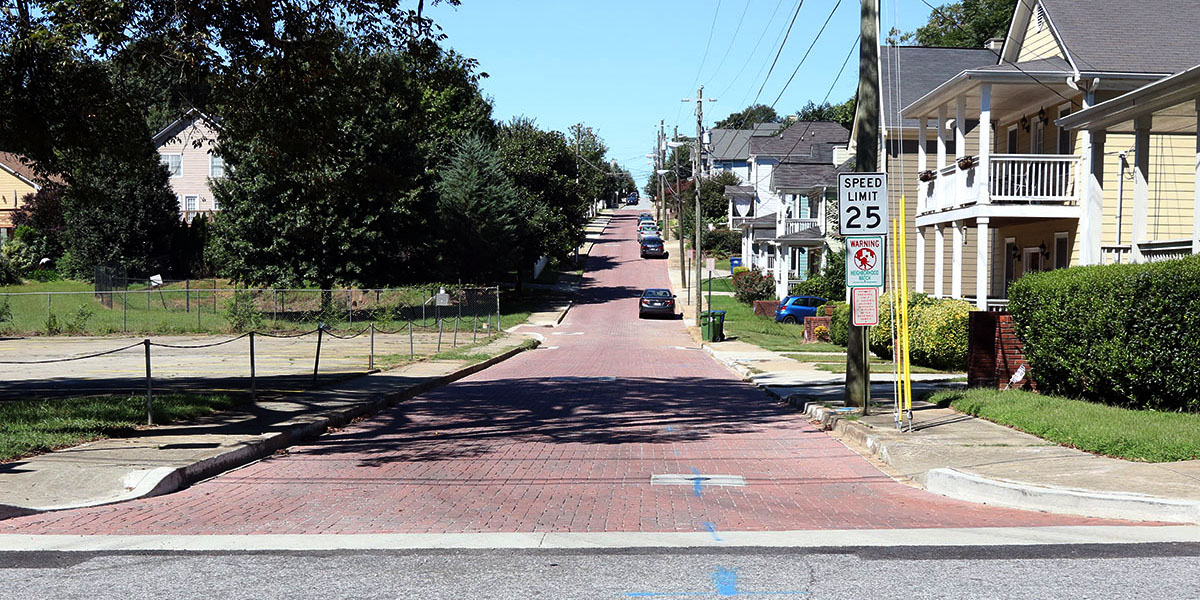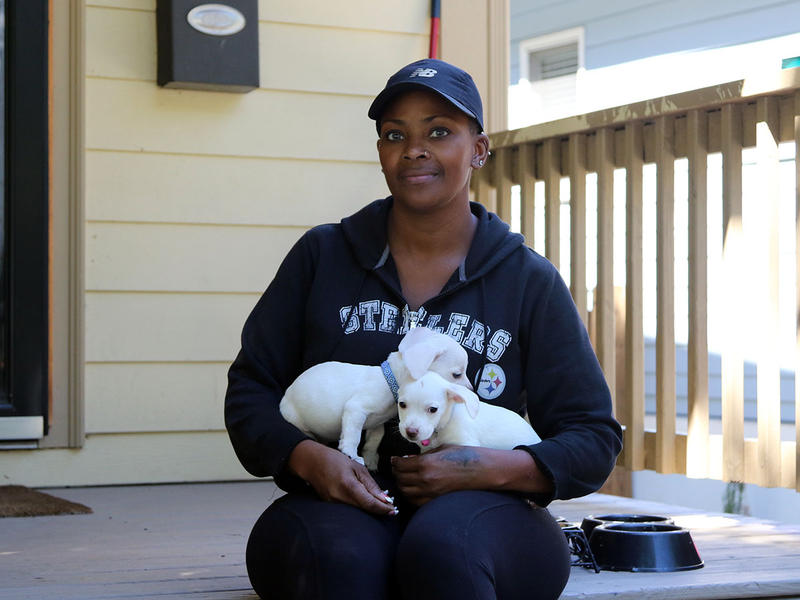Atlanta Is Home To Largest Permeable Pavers Project In US

The city’s Southeast Atlanta Green Infrastructure Initiative began in 2012 to address flooding and sewer overflows.
BRENNA BEECH / WABE
The streets in neighborhoods near Turner Field are starting to look a bit like the yellow brick roads from “The Wizard of Oz.”
That’s because the city of Atlanta is spending nearly $15.8 million ripping out asphalt streets and replacing it with bricks that let water pass through.
It’s the largest permeable paver project in North America.
Green Infrastructure
The project plans began when the neighborhoods of Summerhill, Peoplestown and Mechanicsville saw major flooding in 2012. The heavy rains sent runoff and raw sewage into people’s homes and backyards.
After residents complained, Atlanta Mayor Kasim Reed made a promise.
“My commitment is that I’m going to find a remedy that’s fair and acceptable to the people that live here,” Reed said at the time.
So the city of Atlanta’s Department of Watershed Management started working on the Southeast Atlanta Green Infrastructure Initiative.
Todd Hill is the department’s director of environmental management.
He poured a five-gallon container of water near the intersection of Connally and Crumley streets in Summerhill.
“Instead of running to the curb and gutter and washing down to our actual inlet that would go straight into our combined sewer system – this soaks in between the permeable pavers,” Hill said.
Permeable Pavers
The water stops moving downhill just after a few feet.
Permeable pavers are loosely-spaced bricks with layers of rocks underneath and geo-textile materials to hold back the water. The rocks act as a filtration system to clean the water.
The oils and chemicals on the streets are washed away by the rain and sink 4 feet underground instead of going into the sewer system.
“There is a lot of runoff from urbanization over time and water runs off quicker off of paved services than green surfaces. So basically, this provides a green solution to our stormwater runoff,” Hill said.
Construction Timeline
So far, only one mile has been installed. The city still has another five miles to go. One block typically takes about two weeks, but sometimes it takes longer.
“It’s a very tight area to work in. They have to do very precise work to make sure that they don’t damage anything,” Hill said.
Sometimes workers have to replace water mains that were not installed correctly or use their hands to dig around old pipes before they can lay down the layers of rocks.

CREDIT BRENNA BEECH / WABE
Resident Complaints
Summerhill residents living near the construction site said they’ve had to deal with mud getting into their homes, limited parking and getting groceries and trash cans up the hilly streets is difficult.
Shirelle McNeal is a disabled veteran. She can’t walk far and is nervous about when the project comes to her block.
“We know that the final product is going to be something good, it’s just going through it is really difficult right now,” McNeal said.
The project wraps up in June 2016.
National Trends
Permeable pavers only just started to catch on in the U.S. – with projects in cities like Los Angeles, Chicago, Philadelphia, Portland and even Chattanooga – but it’s actually quite ancient.
“The Roman empire built roads out of stone with flexible pavement underneath … it’s well over 2,000 years old. It’s not new technology,” said Charles Taylor, a national hardscapes consultant with Oldcastle Architectural Products, which is based in Sandy Springs.
One of Oldcastle’s companies, Belgard Pavers, supplied the pavers for the project.
Installing pavers cost at least 20 percent more than asphalt, and that doesn’t include all of the work underground.
EPA Compliance
But even though it’s more expensive, Taylor said cities are finding permeable pavers to be one way to comply with the Environmental Protection Agency’s Clean Water Act.
“Regardless of the financial condition a city is in, they have got to comply with this EPA mandate and after all, I can’t find anyone that really wants to argue about clean water,” Taylor said.
In fact, the biggest driver for this technology is not just flooding, but also federal law. Bethany Eisenberg is director of stormwater services with VHB, an engineering firm in Watertown, Massachusetts.
“Just in the past five years, it’s incredible, the advancement as municipalities are being required to address their water quality impacts from stormwater runoff as well as neighborhood and street flooding,” Eisenberg said.
She said pavers are great for urban areas where land is expensive, but the Northeast has been slow to adopt it with fears of clogging during the winter months.
That’s why she helped write the manual on permeable pavements for the American Society of Civil Engineers.
A Historic Look
“You’re not just getting a pavement – you’re getting a pavement and a stormwater management system all in one,” Eisenberg said.
Georgia Tech professor Babaak Ashuri is director of the school’s Construction Research Center. He said these pavers have a small inconvenience, but in the long run, green solutions to store and treat water should help the environment and maybe even home values.
“There are some complaints that it’s a little bit rough to ride on, but at the same time, it changes look of a neighborhood,” Ashuri said. “Many communities find it pleasant, particularly the historic communities who want to preserve that historic look.”
Summerhill, Peoplestown and Mechanicsville will be Atlanta’s first neighborhoods to get this new look. And for now, they’re the only ones.
9(MDAxODM0MDY4MDEyMTY4NDA3MzI3YjkzMw004))








